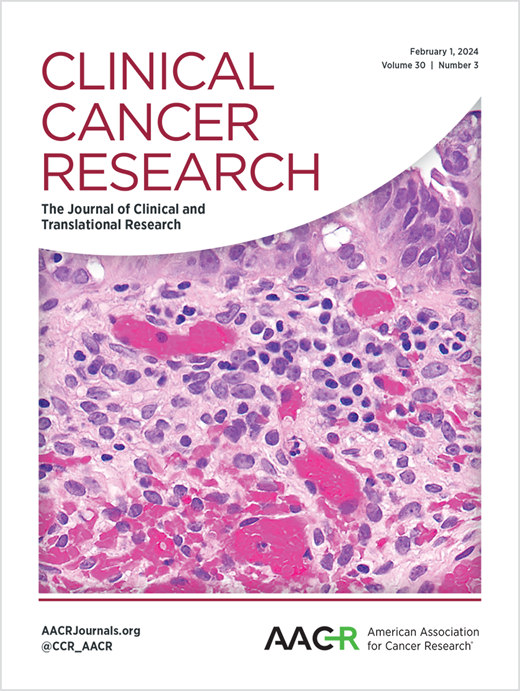SWOG/NCI II 期罕见肿瘤双抗 CTLA-4/PD-1 阻断疗法(DART):非上皮性卵巢癌。
IF 10
1区 医学
Q1 ONCOLOGY
引用次数: 0
摘要
背景双重检查点抑制在晚期罕见/超罕见非上皮性卵巢癌(NEOC)中的作用尚待探索。方法SDART是通过早期治疗和罕见癌症SWOG/NCI委员会开展的一项前瞻性、多中心(1,016个美国研究点)、多队列、单臂II期试验,评估了ipilimumab(抗CTLA-4)(1mg/kg,每6周一次)和nivolumab(抗PD-1)(240mg,每2周一次)在缺乏有效标准疗法的晚期非上皮卵巢癌成人患者中的作用。主要结果是总反应率[ORR;完全反应(CR)/部分反应(PR)];次要结果是无进展生存期(PFS)、总生存期(OS)、临床获益率[CBR;疾病稳定(SD)≥6个月加ORR]和毒性。结果评估了17名患者(中位年龄:64岁;既往治疗次数从0-8次不等,未接触过免疫疗法;8名颗粒细胞瘤患者、6名癌肉瘤患者、1名Sertoli-Leydig患者、1名卵黄囊患者、1名Wolffian患者)。在颗粒细胞瘤中,ORR为25%(n=2/8;1个CR,1个PR),CBR为50%(n=4/8);PFS分别为58.3个月(CR)、50.7+个月(PR)、30.4个月(SD)和8.7个月(SD)。中位 PFS 为 3.5 个月(95% 置信区间 (CI) 1.7-11.2 个月);中位 OS 为 42.5 个月(95% CI 10.1 个月,未达标)。一个Sertoli-Leydig细胞肿瘤的消退率为22%(PFS为11.2个月)。癌肉瘤无反应。3名参与者(18%)因3-4级不良事件而中断治疗。结论Ipilimumab-nivolumab对治疗难治性颗粒细胞瘤具有活性,25%(n=2/8)的患者的CR或PR持续时间超过4年。本文章由计算机程序翻译,如有差异,请以英文原文为准。
SWOG/NCI Phase II Dual Anti-CTLA-4/PD-1 Blockade in Rare Tumors (DART): Non-Epithelial Ovarian Cancer.
BACKGROUND
The role of dual checkpoint inhibition in advanced rare/ultra-rare non-epithelial ovarian cancers (NEOCs) is yet to be explored.
METHODS
DART is a prospective, multicenter (1,016 US sites), multi-cohort, single-arm phase II trial conducted through the Early Therapeutics and Rare Cancer SWOG/NCI Committee, assessing ipilimumab (anti-CTLA-4) (1mg/kg every 6 weeks) and nivolumab (anti-PD-1) (240mg every 2 weeks) in adults with advanced NEOCs who lack beneficial standard therapy. Primary outcome was overall response rate [ORR; complete response (CR)/partial response (PR)]; secondary outcomes were progression-free survival (PFS), overall survival (OS), clinical benefit rate [CBR; stable disease (SD) ≥6 months plus ORR], and toxicity.
RESULTS
Seventeen patients (median age: 64; number of prior therapies ranged from 0-8 with no immunotherapy exposure; 8 granulosa, 6 carcinosarcomas, 1 Sertoli-Leydig, 1 yolk sac, 1 Wolffian) were evaluated. In granulosa cell tumors, ORR was 25% (n=2/8; 1 CR, 1 PR) and CBR, 50% (n=4/8); PFS of 58.3 (CR), 50.7+ (PR), 30.4 (SD), and 8.7 (SD) months. Median PFS was 3.5 months (95% confidence intervals (CI) 1.7-11.2 months); median OS, 42.5 months (95% CI 10.1 months-not reached). One Sertoli-Leydig cell tumor showed a 22% regression (PFS 11.2 months). Carcinosarcomas had no response. Three participants (18%) discontinued treatment due to grade 3-4 adverse events.
CONCLUSIONS
Ipilimumab-nivolumab shows activity in treatment-refractory granulosa cell tumors, with 25% (n=2/8) of patients experiencing either CR or PR lasting over 4 years..
求助全文
通过发布文献求助,成功后即可免费获取论文全文。
去求助
来源期刊

Clinical Cancer Research
医学-肿瘤学
CiteScore
20.10
自引率
1.70%
发文量
1207
审稿时长
2.1 months
期刊介绍:
Clinical Cancer Research is a journal focusing on groundbreaking research in cancer, specifically in the areas where the laboratory and the clinic intersect. Our primary interest lies in clinical trials that investigate novel treatments, accompanied by research on pharmacology, molecular alterations, and biomarkers that can predict response or resistance to these treatments. Furthermore, we prioritize laboratory and animal studies that explore new drugs and targeted agents with the potential to advance to clinical trials. We also encourage research on targetable mechanisms of cancer development, progression, and metastasis.
 求助内容:
求助内容: 应助结果提醒方式:
应助结果提醒方式:


